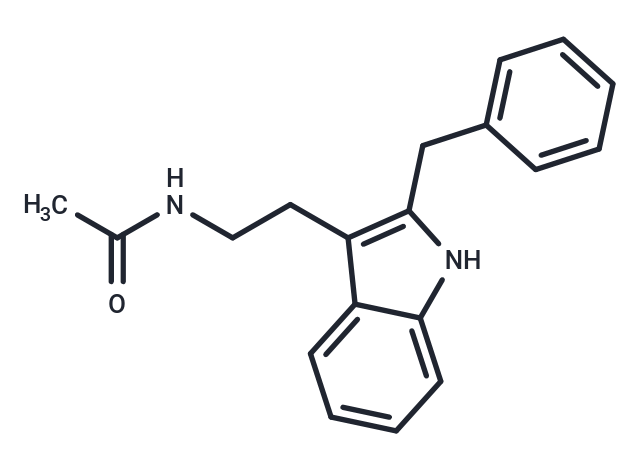Shopping Cart
Remove All Your shopping cart is currently empty
Your shopping cart is currently empty
Luzindole (N-0774) is a selective melatonin receptor antagonist that inhibits experimental autoimmune encephalomyelitis and exhibits antidepressant-like activity. It preferentially targets MT2 (Mel1b) over MT1 (Mel1a), with Ki values of 10.2 nM for human MT2 and 158 nM for MT1.

| Pack Size | Price | USA Warehouse | Global Warehouse | Quantity |
|---|---|---|---|---|
| 1 mg | $47 | In Stock | In Stock | |
| 2 mg | $64 | In Stock | In Stock | |
| 5 mg | $98 | In Stock | In Stock | |
| 10 mg | $148 | In Stock | In Stock | |
| 25 mg | $272 | In Stock | In Stock | |
| 50 mg | $388 | In Stock | In Stock | |
| 100 mg | $568 | In Stock | In Stock | |
| 200 mg | $812 | - | In Stock | |
| 1 mL x 10 mM (in DMSO) | $158 | In Stock | In Stock |
| Description | Luzindole (N-0774) is a selective melatonin receptor antagonist that inhibits experimental autoimmune encephalomyelitis and exhibits antidepressant-like activity. It preferentially targets MT2 (Mel1b) over MT1 (Mel1a), with Ki values of 10.2 nM for human MT2 and 158 nM for MT1. |
| Targets&IC50 | MT2 receptor:10.2 nM(ki), MT1 receptor:158 nM(ki) |
| In vitro | Luzindole (5-10 μg/ml) suppresses antigen-specific proliferation of the MBP-reactive LV-4 T cell line[1]. |
| In vivo | Luzindole (30 mg/kg i.p.) decreases the time of immobility in a dose-dependent manner, the effect being more pronounced at midnight (60% reduction) than at noon (39% reduction). Luzindole (30 mg/kg; i.p.; days 0-5) inhibits experimental autoimmune encephalomyelitis[2]. Luzindole (30 mg/kg i.p.) did not modify the time of immobility either at noon or midnight in the albino ND/4 mouse, or in the C57BL/6J mouse, which does not produce melatonin[3]. The effect of luzindole is time-dependent, showing a maximal effect at 60 min. The anti-immobility effect of luzindole (10 mg/kg i.p.) is prevented by the administration of melatonin (30 mg/kg i.p.). |
| Synonyms | N-0774 |
| Molecular Weight | 292.37 |
| Formula | C19H20N2O |
| Cas No. | 117946-91-5 |
| Smiles | CC(=O)NCCc1c(Cc2ccccc2)[nH]c2ccccc12 |
| Relative Density. | 1.1045 g/cm3 (Estimated) |
| Storage | Pure form: -20°C for 3 years | In solvent: -80°C for 1 year | Shipping with blue ice/Shipping at ambient temperature. | |||||||||||||||||||||||||||||||||||
| Solubility Information | DMSO: 100 mg/mL (342.03 mM), Sonication is recommended. | |||||||||||||||||||||||||||||||||||
| In Vivo Formulation | 10% DMSO+40% PEG300+5% Tween 80+45% Saline: 4 mg/mL (13.68 mM), Sonication is recommended. Please add the solvents sequentially, clarifying the solution as much as possible before adding the next one. Dissolve by heating and/or sonication if necessary. Working solution is recommended to be prepared and used immediately. The formulation provided above is for reference purposes only. In vivo formulations may vary and should be modified based on specific experimental conditions. | |||||||||||||||||||||||||||||||||||
Solution Preparation Table | ||||||||||||||||||||||||||||||||||||
DMSO
| ||||||||||||||||||||||||||||||||||||
| Size | Quantity | Unit Price | Amount | Operation |
|---|

Copyright © 2015-2025 TargetMol Chemicals Inc. All Rights Reserved.